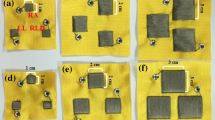Abstract
We measured the electrical activity signals of the heart through vital signs monitoring garments that have textile electrodes in conductive yarns while the subject is in stable and dynamic motion conditions. To measure the electrical activity signals of the heart during daily activities, four types of monitoring garment were proposed. Two experiments were carried out as follows: the first experiment sought to discover which garment led to the least displacement of the textile electrode from its originally intended location on the wearer’s body. In the second, we measured and compared the electrical activity signals of the heart between the wearer’s stable and dynamic motion states. The results indicated that the most appropriate type of garment sensing-wise was the “cross-type”, and it seems to stabilize the electrode’s position more effectively. The value of SNR of ECG signals for the “cross-type” garment is the highest. Compared to the “chest-belt-type” garment, which has already been marketed commercially, the “cross-type” garment was more efficient and suitable for heart activity monitoring.









Similar content being viewed by others
References
Tao, X., Wearable electronics and photonics, 1st edition. Woodhead, Cambridge, 2005.
Paradiso, R., Loriga, G., and Taccinim, N., A wearable health care system based on knitted integrated sensors. IEEE. 93:337–334, 2005.
Fesmire, F. M., Modified limb lead placement for rapid ECG. Am. J. Emerg. Med. 13 (5)603–604, 1995.
Nakamura, H., Shimada, K., and Fujie, T., A comparative evaluation between condition of the wrist band capacitively-coupled ECG recording through signal-to-noise ratio. IEEE EMBS 29th Annual International Conference, 23–26 August 1-4244-0788-5/07, 5886–5889, 2007.
Dunne, L., Smyth, B., and Caulfield, B., Evaluating the impact of garment structure on wearable sensor performance. IEEE Wearable Computers 2007, 11th International Symposium 1-4244-1453-9/07, 2007.
Pola, T., and Vanhala, J., Textile electrodes in ECG measurement. IEEE ISSNIP 3rd International Conference 978-1-4244-1501-4, pp 635–639, 2007.
Burger, H. C., and Van Milaan, J. B., Heart vector and leads. Br. Heart J. 8 (3)157–161, 1946.
Kornreich, F., and Rautaharju, P. M., The missing waveform and diagnostic information in the standard 12 lead electrocardiogram. J. Electrocardiol. 14 (4)341–350, 1981.
Kornreich, F., Rautaharju, P. M., Warren, J., Montague, J., and Horacek, B. M., Identification of best electrocardiographic leads for diagnosing myocardial infarction by statistical analysis of body surface potential maps. Am. J. Cardiol. 56 (13)852–856, 1985.
Rautaharju, P. M., Prineas, R. J., Crow, R. S., Seale, D., and Furberg, C., The effect of modified limb electrode positions on electrocardiographic wave amplitudes. J. Electrocardiol. 13 (2)109–113, 1980.
Soliman, E. Z., Recording electrocardiograms using 3-limb lead cables instead of the standard 4: a modification to minimize incorrect electrode placements. J. Electrocardiol. 41:391–392, 2008.
Zao, Z. Z., A geometric study of the relationship between limb leads and cardiac vector in the frontal plane. Am. Heart J. 59 (2)249–262, 1960.
Frank, E., Theoretic analysis of the influence of heart-dipole eccentricity on limb leads, Wilson central terminal voltage and the frontal-plane vectorcardiogram. Circ. Res. 1:380–388, 1953.
Frank, E., General theory of heart-vector projection. Circ. Res. 2:258–270, 1954.
Acknowledgement
This work was supported by the Ministry of Knowledge Economy of the Korean Government.
Author information
Authors and Affiliations
Corresponding author
Rights and permissions
About this article
Cite this article
Cho, HS., Koo, SM., Lee, J. et al. Heart Monitoring Garments Using Textile Electrodes for Healthcare Applications. J Med Syst 35, 189–201 (2011). https://doi.org/10.1007/s10916-009-9356-8
Received:
Accepted:
Published:
Issue Date:
DOI: https://doi.org/10.1007/s10916-009-9356-8




